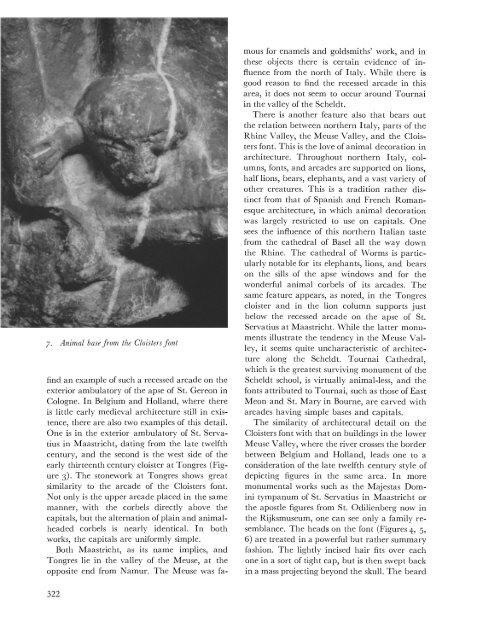The Case of the Calcite Font - The Metropolitan Museum of Art
The Case of the Calcite Font - The Metropolitan Museum of Art
The Case of the Calcite Font - The Metropolitan Museum of Art
Create successful ePaper yourself
Turn your PDF publications into a flip-book with our unique Google optimized e-Paper software.
7. Animal base from <strong>the</strong> Cloisters font<br />
find an example <strong>of</strong> such a recessed arcade on <strong>the</strong><br />
exterior ambulatory <strong>of</strong> <strong>the</strong> apse <strong>of</strong> St. Gereon in<br />
Cologne. In Belgium and Holland, where <strong>the</strong>re<br />
is little early medieval architecture still in existence,<br />
<strong>the</strong>re are also two examples <strong>of</strong> this detail.<br />
One is in <strong>the</strong> exterior ambulatory <strong>of</strong> St. Servatius<br />
in Maastricht, dating from <strong>the</strong> late twelfth<br />
century, and <strong>the</strong> second is <strong>the</strong> west side <strong>of</strong> <strong>the</strong><br />
early thirteenth century cloister at Tongres (Figure<br />
3). <strong>The</strong> stonework at Tongres shows great<br />
similarity to <strong>the</strong> arcade <strong>of</strong> <strong>the</strong> Cloisters font.<br />
Not only is <strong>the</strong> upper arcade placed in <strong>the</strong> same<br />
nzanner, with <strong>the</strong> corbels directly above <strong>the</strong><br />
capitals, but <strong>the</strong> alternation <strong>of</strong> plain and animalheaded<br />
corbels is nearly identical. In both<br />
works, <strong>the</strong> capitals are uniformly simple.<br />
Both Maastricht, as its name implies, and<br />
Tongres lie in <strong>the</strong> valley <strong>of</strong> <strong>the</strong> Meuse, at <strong>the</strong><br />
opposite end from Namur. <strong>The</strong> Meuse was fa-<br />
mous for enamels and goldsmiths' work, and in<br />
<strong>the</strong>se objects <strong>the</strong>re is certain evidence <strong>of</strong> influence<br />
from <strong>the</strong> north <strong>of</strong> Italy. \Shile <strong>the</strong>re is<br />
good reason to find <strong>the</strong> recessed arcade in this<br />
area, it does not seem to occur around Tournai<br />
in <strong>the</strong> valley <strong>of</strong> <strong>the</strong> Scheldt.<br />
<strong>The</strong>re is ano<strong>the</strong>r feature also that bears out<br />
<strong>the</strong> relation between nor<strong>the</strong>rn ltaly, parts <strong>of</strong> <strong>the</strong><br />
Rhine Valley, <strong>the</strong> Meuse Valley, and <strong>the</strong> Cloisters<br />
font. This is <strong>the</strong> love <strong>of</strong> animal decoration in<br />
architecture. Throughout nor<strong>the</strong>rn Italy, columns,<br />
fonts, and arcades are supported on lions,<br />
half lions, bears, elephants, and a vast variety <strong>of</strong><br />
o<strong>the</strong>r creatures. This is a tradition ra<strong>the</strong>r distinct<br />
from that <strong>of</strong> Spanish and French Romanesque<br />
architecture, in which animal decoration<br />
was largely restricted to use on capitals. One<br />
sees <strong>the</strong> influence <strong>of</strong> this nor<strong>the</strong>rn Italian taste<br />
from <strong>the</strong> ca<strong>the</strong>dral <strong>of</strong> Basel all <strong>the</strong> way down<br />
<strong>the</strong> Rhine. <strong>The</strong> ca<strong>the</strong>dral <strong>of</strong> Worms is particularly<br />
notable for its elephants, lions, and bears<br />
on <strong>the</strong> sills <strong>of</strong> <strong>the</strong> apse windows and for <strong>the</strong><br />
wonderful animal corbels <strong>of</strong> its arcades. <strong>The</strong><br />
same feature appears, as noted, in <strong>the</strong> Tongres<br />
cloister and in <strong>the</strong> lion column supports just<br />
below <strong>the</strong> recessed arcade on <strong>the</strong> apse <strong>of</strong> St.<br />
Servatius at Maastricht. V\;hile <strong>the</strong> latter monuments<br />
illustrate <strong>the</strong> tendency in <strong>the</strong> Meuse Valley,<br />
it seems quite uncharacteristic <strong>of</strong> architecture<br />
along <strong>the</strong> Scheldt. Tournai Ca<strong>the</strong>dral,<br />
which is <strong>the</strong> greatest surviving monument <strong>of</strong> <strong>the</strong><br />
Scheldt school, is virtually animal-less, and <strong>the</strong><br />
fonts attributed to Tournai, such as those <strong>of</strong> East<br />
Meon and St. Mary in Bourne, are carved with<br />
arcades having simple bases and capitals.<br />
<strong>The</strong> similarity <strong>of</strong> architectural detail on <strong>the</strong><br />
Cloisters font with that on buildings in <strong>the</strong> lower<br />
Meuse Valley, where <strong>the</strong> river crosses <strong>the</strong> border<br />
between Belgium and Holland, leads one to a<br />
consideration <strong>of</strong> <strong>the</strong> late twelfth century style <strong>of</strong><br />
depicting figures in <strong>the</strong> same area. In more<br />
monumental works such as <strong>the</strong> lVIajestas Domini<br />
tympanum <strong>of</strong> St. Servatius in Maastricht or<br />
<strong>the</strong> apostle figures from St. Odilienberg now in<br />
<strong>the</strong> Rijksmuseum, one can see only a family resemblance.<br />
<strong>The</strong> heads on <strong>the</strong> font (Figures 4, 5,<br />
6) are treated in a powerful but ra<strong>the</strong>r summary<br />
fashion. <strong>The</strong> lightly incised hair fits over each<br />
one in a sort <strong>of</strong> tight cap, but is <strong>the</strong>n swept back<br />
in a mass projecting beyond <strong>the</strong> skull. <strong>The</strong> beard<br />
322
















